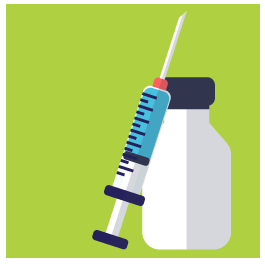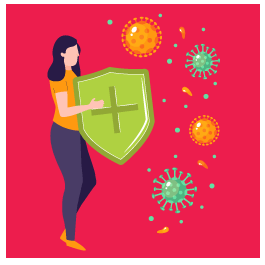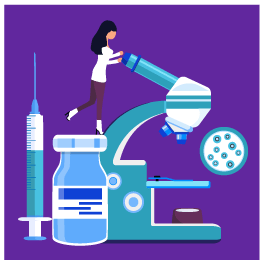The Coronavirus has sparked renewed conversation around vaccines and their development, as medical researchers race to develop a vaccine for COVID-19. There is a significant amount of misinformation on the Internet, so we’re dispelling myths and explaining the basics of vaccinations and immunity.

What is a vaccine?
First things first – what is a vaccine? A vaccine is an injection that uses all or part of the cells of a disease (virus or bacteria) that have been killed or weakened in order to stimulate your immune system to produce antibodies. The measles vaccine contains the measles virus.
Once the body is producing antibodies, you develop immunity to the disease and, if exposed to it in the future, this immunity prevents you from getting sick. Vaccines are beneficial because they treat you for a disease before you ever get sick, which is especially important with viruses, which are harder to treat once you contract them.
Are all vaccines the same?
No – there are three types of vaccines.
- Live Attenuated: These vaccines use live attenuated (or weakened) forms of the virus or bacteria used to generate an immune response without spreading to other people. They typically provide long-term immunity. These vaccines can be used with bacteria, but are most common with viruses and can sometimes cause mild immune response (feeling ill). Because the vaccines contain live disease agents, they are not typically recommended for those with weakened immune systems.
- Inactivated: An inactivated (or “killed”) vaccine contains bacteria or virus that has been deactivated with a chemical or with heat. These types of vaccines tend to have fewer side effects, but also produce a more mild immune response.
- Subunit/Conjugate: This type of vaccine uses a part of the disease cell that will create an immune response and not the entire cell. Influenza (flu) and Pertussis vaccines are examples of these. For infants, these are called Conjugate vaccines, because the part of the cell used is chemically conjugated, or linked to, a carrier protein.

What are the differences between active, passive, and herd immunity?
Active immunity comes from direct exposure to a disease, whether it’s a vaccine, you become ill, or you have been exposed to an illness and experience an asymptomatic response (in which case, you may not know that you have developed immunity).
Passive immunity occurs when a person is given antibodies, rather than producing them. This happens with newborn babies through the placenta or blood transfusions. This type of immunity is not permanent.
Herd or Community immunity occurs when enough people are immune to a disease that the germs can’t easily travel from person to person, which reduces the overall risk for the entire population. This type of immunity is most common due to vaccines and protects everyone, but especially the most vulnerable – people with weakened immune systems or those who can’t be vaccinated.

How are vaccines made?
Vaccines are made by growing large numbers of the pathogen (or disease cells) for the desired immune response. Then, the cells must be isolated – removed from the medium they were grown in. Then the cells must be purified and inactivated if an Inactivated vaccine is being made. Next, materials are added to enhance immune response and to stabilize the vaccine for storage.
Finally, the vaccine is packaged and distributed for use. If a vaccine has developed for a specific disease, there are many steps prior to mass development and distribution that usually require years of research, development, trials, and (in the event of trial success) approval and licensure by the FDA. This process can take up to 15 years, which is why there is concern about how quickly a COVID vaccine can be produced.
Each vaccine comes with a Vaccination Information Statement indicating possible expected side effects (usually mild symptoms resulting from an immune response), and any concerning symptoms to keep an eye out for. The risks of not vaccinating far outweigh the very small risks of adverse effects. In the US in 2019, there were 1,282 reported cases of measles, a disease that had been declared eradicated in the US in 2000.
You can learn more about vaccination history, production, risks, and schedules from the CDC, vaccines.gov, and historyofvaccines.org.


Back to Blog